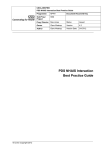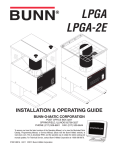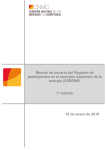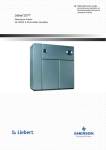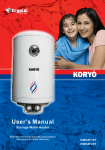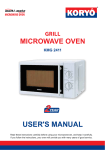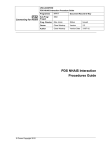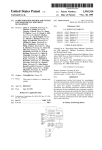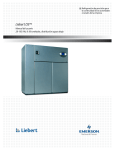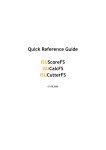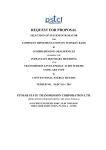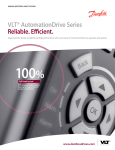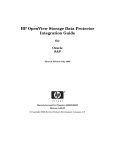Download a new framework for semantically interoperable
Transcript
International Journal of Information Technology and Knowledge Management July-December 2011, Volume 4, No. 2, pp. 643-647 A NEW FRAMEWORK FOR SEMANTICALLY INTEROPERABLE HOSPITAL INFORMATION SYSTEM Kulvinder Singh Mann1, Harshsad Awarti2 & Meenakshi3 This paper represents a remote to home database communication structure of HIS (Hospital Information System) in HL 7. It addresses constitutent’s mobility, power consumption, data storage, data transmission and device synchronicity for wireless wearable home care devices. The resent efforts to make inter-opera ability between certain devices to make effective and faster and secure data transmission between remote and local database and systems vice-versa using Relational database MaxDB and LabVIEW. Keywords: HL7, HIS, Relational Database, MaxDB, LabVIEW. 1. INTRODUCTION The dramatically increasing demands of health care cannot be satisfied with the traditional model of face-to-face patientphysician consultation. So in the early 1990s, telemedicine was introduced which via point-of-care gave a promising solution for this dilemma. The telemedicine has promoted the home monitoring capabilities. A major step in home monitoring will be that, the data captured at the home could be added directly to the hospital electronic patient records[1]. And due to these advances in home monitoring large amount of the patient’s data are generated outside the hospitals. In each and every hospital doctors need a secured and correct data about the patient. This can be achieved by using the local and remote database system. Here inoperability standard and HL7 standards are used. Interoperability is the ability of a software or hardware of different machines and vendors to share the resources. These medical systems will be similar to upcoming ubiquitous computing environments. These virtual medical systems are comprised of interoperable components from multiple vendors. These systems will be assembled on-the-fly for different healthcare scenarios, sharing data with one another through established information exchange standards. The collection of individual devices will present a data about the state of health of a patient. These devices will be worn by the patient and will also inhabit with his/her surrounding environment [2]. the Figure 1 represents a functional infrastructure for a home monitoring system that utilizes wearable components and interoperability standards. Department of Computer Engg and Information Technology, GuruNanak Dev Engineering College Principal R.I.M.T College Mandi Gobindgarh Department of Computer Engg, Govt. Polytechnic College G.T.B Garh Moga E-mail: [email protected], 3meenakshi_kkk@yahoo. co. in Fig.1: Communication Between a Remote Database and a Home Computer First of all the data is collected by the sensors. These sensors are located on patient and in their nearby environment. After that these sensors uploads the information about the patient into the data logger. Once the information is stored in the data logger, it uploads its measurements to base station and then it uploads all the information into local database through the LabVIEW program. The purpose of lab view is, to update the patient information into local database for storage. At last the HL7 standard transmits the local database information into remote database. Now all the patient information is stored in the hospital record i.e. in remote database. From where the physician can easily access the patient’s information and can issue commands through HL7 message to the home monitoring [3]. All the data transmission from the sensors to the logger is done wirelessly by using the Bluetooth standards. And the communication between the home-based monitoring devices is controlled through a modified version of MIB (Medical Information System) or IEEE 1073 standard. The chameleon software is used to control the HL7 messaging service [2]. 644 K ULVINDER S INGH M ANN , H ARSHSAD A WARTI & M EENAKSHI 2. METHODOLOGY This type of point-of -care Hospital Information System is comprised of following parts: A. Data Logger, Sensor and LabVIEW First of all, data is collected by sensors which transmit it to logger. A data logger is also called data recorder is an electronic device that is used to store and monitor the data. Data logger can operate independently of a computer. They send the measures taken by them to the home computer by radiofrequency. Software is installed on the home computer that monitors the working of logger. This software is called LabVIEW. The logger sends the patients data in real time to the home computer or local database [3]. A hierarchical arrangement of sensors and logger is shown in Fig. 2. Fig. 2: Hierarchical Arrangement of Loggers and Sensors B. IEEE 1073 Standard Point-of-care device must be easy to use and reconfigure. This feature is also known as plug and play (PnP). PnP refers to the interoperability between the devices of various vendors. Standardization is necessary to make devices plug and play. Message standard are needed to cope with the complexity of flow of information between the home-based monitoring devices. The MIB standard suits best for home point-of-care devices. This standard defines a group of standards to provide interoperability of medical devices. It is consist of four sub standards i.e. p1073.1, p1073.2, p10732.3 and p1073.4. These standards specify information representation or interchange, Application layer, Transport layer and Physical layer respectively [1]. C. A Local Database-Software, Tables and Procedures A database is as a shared collection of logically related data and a description of this data to meet the information requirements of an organization. A relational database is a collection of tables. These tables are arranged in a rows and columns. Each column has a unique name. Various data types are used like integer, string, float etc. Rows are independent entries to a database tables. A row in a table represents a relationship among a set of values called tables. Each patient corresponds to a separate row, containing entries. Relationships are also considered. A relationship is association among several entities like One to one relation, one to many relation, many to one relation and many too many relation. These relationships define the placement of primary keys, unique and foreign keys. A primary key is a set of one or more attribute of attributes that uniquely identifies tuples within the table. The foreign key reference to columns in other tables. MaxDB was chosen for the local database software. MaxDB is delivered with a set of administration and development tools which provides both the GUI (Graphical User Interface) and CLI (Command Line Interface). MaxDB is cross platform compatible. This database software is cheap and it supports many advanced features like procedures, cursors, triggers, standard SQL (Structured Query Language) operations, user functions, assertions, referential integrity etc. MaxDB provides various methods for the security of patient’s information. There are various restrictions on the data that can be specified on a relational database schema in the form of constrains. These are domain constrains, key constrains, entity integrity and referential integrity and data dependencies, backup, avoidance of redundancy etc [4]. To access any information the user must first log into the database, but logging into the database does not give the user the complete freedom. The table, row and column access can be controlled by granting the privileges only to the trusted users. MaxDB ensures the data integrity, reliability and availability. Fig.3 represents the MaxDB structure. Fig. 3: MaxDB Database D. HL7 Standard Health level seven is for patient or computers to be able to share clinical data with each other, it includes following: 1. A functional is used to physically communicate, i.e. speak and hear and receive document, data files, share data and information. This function is known as functional interoperability. 2. A function is to speak a common language and share the communication vocabulary that allows them to understand complex medical difficulties. This function is known as semantic interoperabilit. Health level seven specifies a number of different A N EW F RAMEWORK FOR S EMANTICALLY I NTEROPERABLE H OSPITAL I NFORMATION S YSTEM standards, guidelines and methodologies which communicates with each other for many types of healthcare systems and can be shared information and follow set of rules in uniform manner to allow healthcare organization to easily share clinical information. Health level seven includes these standards-Conceptual standards, Document standards, Application standards, messaging standards. For home based HL7 interfacing we use the flexible HL7 chameleon tool. This tool is based on client server approach. Chameleon has a database called DB direct. This database places the received messages into the tables or relations, encrypts them and then formats them into HL7 format for transmissions. HL7 v2.x has become the most widely used standard for message transmission. E. Feedback System Home monitoring systems can be passive or active in nature. In passive monitoring the sensors works as per their configuration. In active monitoring system the doctor first remotely views the patients information and then do changes to the monitoring system as per required. Like if a doctor wants to increase the sample rate of the pulse oximator, he will simply send the HL7 message through the chameleon server as shown in Fig 1. 3. INTEROPERABILITY TEST FRAMEWORK Building the HL7-based system by using the different standards requires a dynamic and configurable test framework. We use an interoperability test framework called TestBATN framework to test the interoperability stack of HL7-based system. This framework is used for conformance evaluation along with the prediction of the system’s ability to function collaboratively. It is constructed in the JAVA platform. Their graphical user interfaces are implemented using Adobe Flex2.0.1.TestBATN framework has various features like: 1. A test execution model that controls the different layers (such as business process layer, application layer, transport layer and network layer) of interoperability stack. 2. A computer interpretable test description language which modifies and maintains test functionality and provides flexibility to design. 3. It is a web-based framework. Hence the vendors can test their product over the web [5]. 645 RESULTS Security in MaxDB is detailed and provides methods for protecting patients’ privacy. Users must log into the database to access any information, but in logging system it does not give the user complete freedom. Entire table and column access may be controlled by granting select, insert, update or delete privileges only to users, but the execution of database procedures also require the proper privileges. An enterprise level database, MaxDB also offers logging, backup and transactions to ensure data integrity and availability [3]. In this paper LabVIEW software is used, all the LabVIEW programs that call database procedures to store data, this stored data acquired from sensors. Using sensors measurements are taken from the LabVIEW programs. If LabVIEW programs can call database procedures, then MaxDB itself must be set up and running. Using following query, measurements can be taken regarding any reading, for example we want to know about ECG reading, and then this query will be used. REFERENCES [1] J. Yao, R. Schmitz, and S. Warren, “A Wearable StandardsBased Point-of-Care System for Home Use”, 25th Annual Conference of the IEEE EMBS, Fiesta Americana Grand Coral Beach Hotel, Cancun, Quintana Roo, Mexico, September 17-21, 2003, pp. 3732-3735. [2] S. Warren, J. Yao R. Schmitz, and L. Nagl, “Wearable Telemonitioring System Designed with Interoperability in mind”, 25th Annual Conference of the IEEE EMBS, Fiesta Americana Grand Coral Beach Hotel, Cancun, Quintana Roo, Mexico, September 17-21, 2003, pp. 3736-3739. [3] J. W. Lebak, J. Yao, and S. Warren “HL7-Compliant Healthcare Information System for Home Monitoring” 26th Annual Conference of the IEEE EMBS, San Francisco, CA, USA, September 1-5,2004, pp. 3338-3341. [4] MySQL, “MaxDB by MySQL”, April 09, 2004.http:// www.mysql.com/products/maxdb/index.html. [5] HL7, “HL7 Resource Library”, April 09, 2004. http:// www.hl7.org. [6] Connecting for Health Data Standards Workgroup, “The Data Standards Working Group Report”, June 5, 2003. http:// www.connectingforhealth.org/resource/DSWG_Report.pdf. [7] MySQL, “MaxDB by MySQL: Documentation”, April 09, 2004. http://www.mysql.com/documentation/maxdb/ default.htm. [8] “National Instruments LabVIEW Database Connectivity Toolset User Manual. May 2001”, National Instruments Corporation, http://www.ni.com/pdf/manuals.



